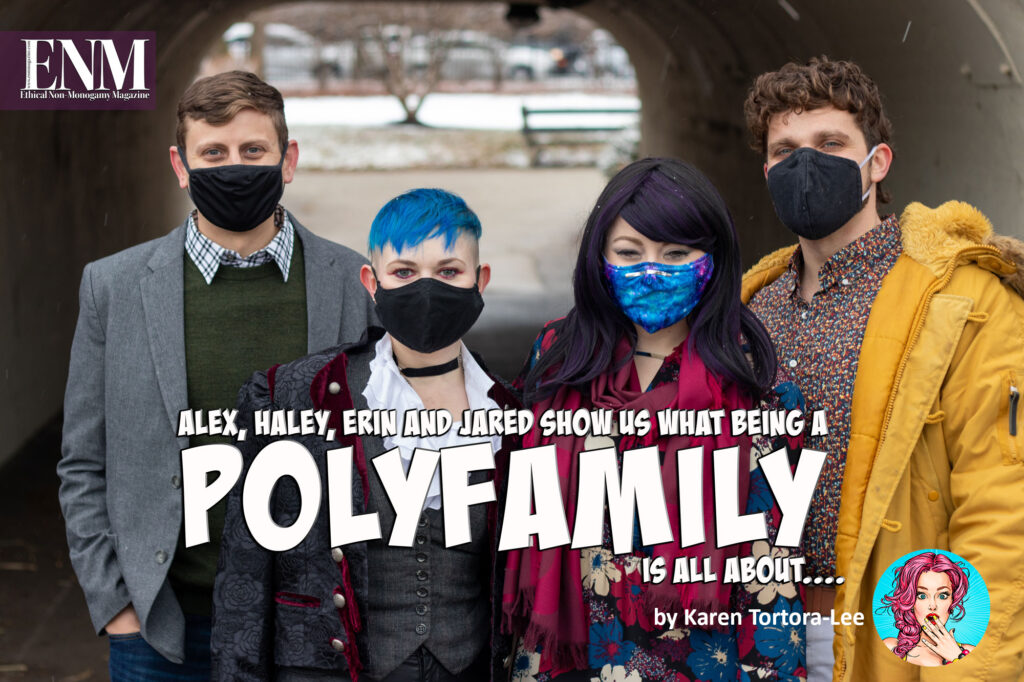
Welcome to this month’s Temptation article where we celebrate the polycule! So, what exactly is a polycule? Not everyone in the ENM community may be familiar with this
portmanteau of “polyamory” and “molecule,” but it basically just refers to any connected network of non-monogamous relationships. A “vee” (three folks where one is the center or pivot, and the two other partners are not sexually involved with each other) is probably the smallest possible size of polycule, but polycules are often far more complex with a larger web of people, who are all involved with each other in one way or another.
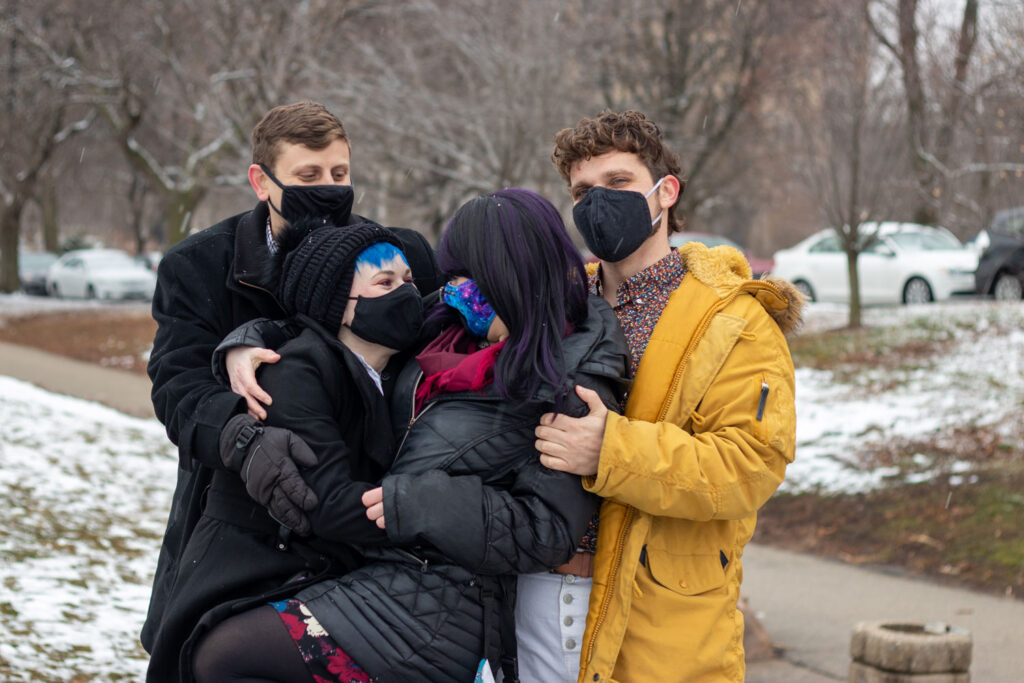
This month we’re featuring Erin (she/her), who identifies as pansexual; Alex (he/him), who identifies as bi/pansexual; Hayley (she/they), who identifies as pansexual and genderfluid; and Jared, (he/him); who feels pansexual is “probably more accurate to start using, in order to ditch the gender binary”.
CONNECTIONS
While the main people we’re focusing on are Erin, Alex, Hayley and Jared, they have loads more links, in what Jared best describes as their “rolling landscape”. An exact number that is often hard to pin down.
“I mean, there are a lot of people in our polycule, if you’re counting the people who we’re all dating outside of each other!” says Hayley. “I haven’t actually sat down and counted”.
“When you start counting partners, metas, partners of metas, queerplatonic relationships, and play partners, it is really difficult to nail down an exact number of people in our polycule!” says Erin.
“Depends!” says Alex. “Typically I have about ten to fifteen people in my close polycule. That changes. Often on a month to month basis! For the last year though my polycule has mostly just been Erin because of Covid!”
“We’re all seeing too many other folks to various degrees to put an absolute number on who is “in” and who is “out”, says Jared. “When you add to that, the fact that many of us have intimately close, but non-sexual relationships, sexual, but not intimate relationships, and sexy friendships… well it just goes on even further.”
“Our polycule is ever growing and changing as new relationships develop and/or existing relationships grow/transition into new dynamics”, says Erin. “While I can’t speak to every person in our polycule, I would say that the majority of my partners, metas, and queerplatonic relationships prefer a non-hierarchical, kitchen-table approach to polyamory.”
“I also like to include queerplatonic relationships in that number,” says Hayley, “because I feel like a polycule would include all people you and your partners are trying to build a life with. Let’s just say, if we had to make our polycule tree, it would have so many branches!”
Okay then! Let’s start climbing up that tree and examining some of these branches. Who is with who and how did it all happen? Alex is engaged to Erin (who he lives with) and is also partnered with Hayley. Erin is partnered with Alex (her nesting partner), Hayley, and Jared. Hayley is partnered with Erin, Alex, Jared, and three other people outside of them. And Jared is dating Erin, Hayley, as well as one of Hayley’s nesting partners.
“Because Hayley is also partnered with Alex and Jared, some people might consider or assume that the four of us are a quad, but that is not the case (nor are any of the three of us in a triad with one another),” says Erin. Hayley, however IS in a triad with her nesting partners. “So I am dating six people in total,” says Hayley, “and they’re all dating other people as well.”
“I have another long-term/close relationship that’s a few months short of three years,” says Jared, “Which has developed into a bit of a quad situation during Covid (basically, I hit it off with my meta’s nesting partner so, I’ve started dating them over the past few months). I have another relationship that’s about to hit the two year mark as well, which is exciting!”
“In addition to my three established partnerships, I also have a few more loosely defined queerplatonic relationships and play partners,” Erin adds. “While my QPRs and play partners may not orbit as closely to me (meaning, I may not see or talk to them as often) as my partners, those connections are still just as valuable, significant, and meaningful in my life.”
“I have been with one of my nesting partners for ten years,” says Hayley. “He and I opened up our relationship about eight years ago. My other nesting partner and I started dating about four years ago (when we formed the triad). I met Alex at a polyamory meetup event, and so we have been together for over three years now! My other partner (unnamed) and I are almost going on three years as well. I started dating Jared in August of 2019 and then I started dating Erin in November of 2019. Erin and I were both already dating Jared and Alex by the time we developed feelings for each other. In our polycule, it’s not uncommon to end up dating metamours! Not every polycule is like that, and that’s okay too. For me, I develop crushes on people the more I know them!”

Erin first met Hayley in April of 2018 through a Facebook polyamory group, when Hayley commented on one of her posts. They were both living in Chicago, with Hayley just a few blocks away from Erin’s workplace. At the time, friendship sparked, but didn’t firm up until about a year later. That was when Erin began attending the local queer polyam events that Hayley was hosting. “It was through these events that I met both Jared and Alex (and many of the other amazing people in our polycule),” says Erin. “Jared and I began dating in July of 2019, Alex and I started in September of 2019, and Hayley and I started in November of 2019. You could say it was a pretty eventful six months in my life! What was really surreal for me was realizing that for almost a year and a half, through being friends with Hayley on Facebook, I had been seeing posts and pictures of people who would soon become some of the most important people in my life – my chosen family.”
Alex met Hayley through his first partner in polyamory – Hayley’s spouse was Alex’s meta with that partner. “I first met Hayley at a Chicago Polyamory Cocktails (CPC) event that Hayley was hosting,” he says, “though it wasn’t for some time later that we began to date. Our first date went well and it’s been great ever since! When I met Erin I had three partners including Hayley.” Erin and Alex met at Queer Polyamory Cocktails (QPC), which is a group Hayley started in Chicago. “I remember thinking Erin was super cute, but feeling particularly shy so I had no intent to go talk to Erin.” says Alex. “In what felt like ten seconds later, Erin came right up to me and said, “Hi, I’m Erin!” We talked most of the night and shared a bus towards our respective homes talking the whole way. We pretty much haven’t stopped talking to each other since!”
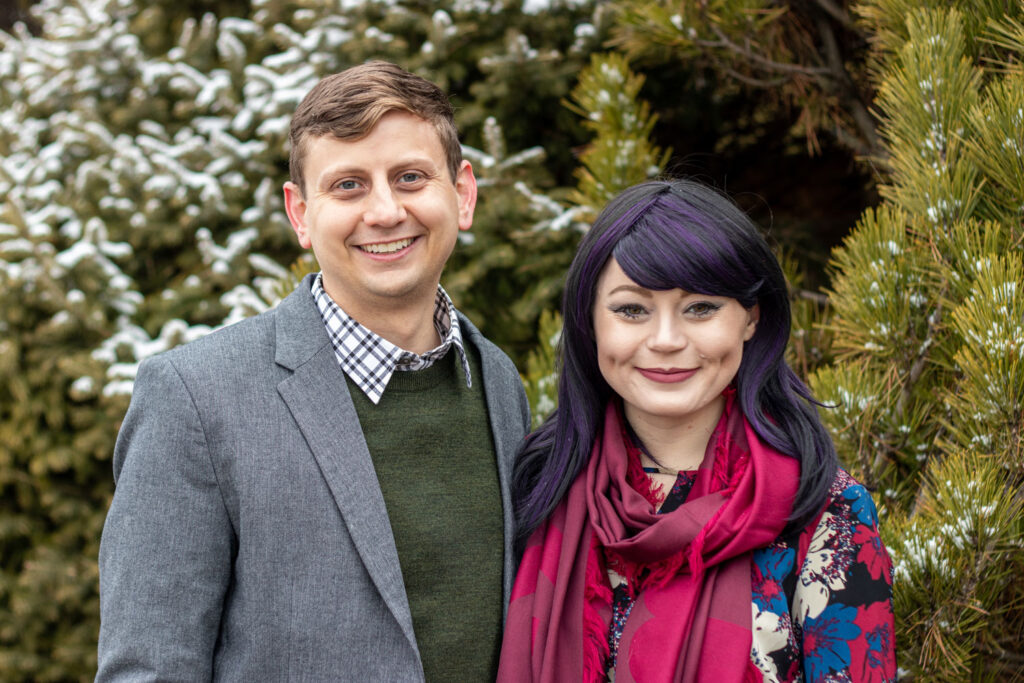
When Erin was unexpectedly looking for a new living situation in November of 2019, Alex offered his spare room. “Because we hadn’t been partnered for very long, we established clear boundaries between the two of us that I was moving in as a roommate who also happened to be a partner, but not as a nesting partner,” she says. “It wasn’t until several months later, (and after the pandemic hit) that we started considering each other as more intentional nesting partners. Now, over a year later, we made the decision to get engaged! Nothing like quarantining together during a global pandemic to bring people closer to one another!”
LIVING THE LIFESTYLE
There’s no doubt that Covid has put a crimp in the ENM lifestyle. Engaging with others just isn’t what it used to be, and socializing can look a lot different now. But I was curious to know how this group of four participated with others during safer times — and what were the ground rules?
“Pre-Covid I loved playing with people outside the polycule!” says Alex. “Or in the polycule! I always approach everything with the same basic philosophy: be honest. It’s a large part of why I click so well with both my partners. We are all open, honest people who just want to make sure everyone is making the authentic choice for themselves and their happiness.”
“Pre-Covid,” says Hayley, “I would absolutely play or have sex with people outside of the people I am dating. I definitely communicate my boundaries to my current partners and my play partners. If I have a new sexual partner, I tell my partners just so that they are informed. I get STI screenings every three months or sooner, and also will do so upon request.”
“Pre-Covid,” says Jared, “I’d get a full panel test every three to four months. Personally, I like to limit not using barriers for penetrative sex to one person maximum to keep things simple in regards to having a higher risk of transmitting anything prior to it showing up in a test.”
In addition to STI testing, it’s also important to have conversations around barriers and safe sex practices.
“If a partner and I choose to not use barriers with each other for penetrative sex and they choose to not use barriers with someone else,” says Erin, “then I would expect them to inform me prior to the next time we are sexually intimate with each other so that I may choose whether or not to use a barrier with them. If I have this kind of agreement with a partner, I don’t expect them to tell me ahead of time that they plan to not use barriers with someone else (though it is preferred), but I do expect them to give me informed consent once it happens.”
Boundaries and risk are something Jared talks about, “with anyone I’m with before having any kind of sex to nail down what we’re both comfortable with and what kind of risk we’re generally exposed to; this involves not only talking about what we expect from each other one on one, but what kind of information we need communicated regarding anyone outside of that.”
Pre-Covid, socializing with other polycules and polyamourous people was a big part of everyone’s lives. So how did they manage to fit everything in? And what did that mean for their polycule?
“I’m a VERY social person,” says Alex, “and in my typical calendar I might have had one night a month where I’m at home alone relaxing.” He definitely considers himself a, “the more the merrier” type of person. In terms of dealing with new partners, Alex says, “I think generally, most of the people I surround myself with are thoughtful people who are good at making new people feel welcomed. That said, everyone is different and the experience introducing a new person to the group is going to be different every time… It’s part of the fun! Challenges are typically time related. There is only so much time in a week and sometimes it’s not always possible to give everyone what you want to give them and that they need. That’s not fun either, if one becomes “poly-saturated”. Certainly there will always be personality clashes. We are human, it is inevitable. The question is how does one handle the clashes. All I care about is people handle conflict the best they can! Also to never stop improving!”
Erin’s ENM journey began over five years ago, when she began attending local swinger events with her spouse (at the time). She discovered polyamory a few months later, and has been active in both communities ever since. “Prior to Covid,” she says, “I was attending and playing at swinger parties (sometimes solo, sometimes with partners) on a regular basis. For a little over a year, I got to work as the event manager for one of the local lifestyle event companies where I hosted monthly themed parties with 100+ attendees. Over the last five years, I’ve met and played with some amazing people in the swinging lifestyle, many of whom I would still count among some of my closest friends.”
Nowadays, however, most of her interacting with the broader ENM community is done online, primarily in Facebook groups.
“I think online communities are a great resource as well,” says Hayley. “I have even done Zoom hangouts with people from these groups, and hopefully we can meet when it’s safe to do so”
Pre-Covid, Hayley hosted a lot of polyamory meetups, keeping herself pretty busy. “I think community is really important,” She says, “and so is having friendship and other connections outside of your polycule.”
As far as challenges go, “scheduling can definitely be a challenge when there are this many relationship dynamics to consider. Google calendar is our best friend,” Erin says. Time may sound like one of the biggest challenges, but what about feelings? “I think my reaction to when my partners start dating someone new is different per partner and per situation,” says Hayley. “Mostly, it’s pretty easy to accept, especially because my partners are very communicative and also very reassuring. I’m big on words of affirmation, so “I’m starting to date this person, and I still like you,” is quite often all I need to hear. There were other times with former partners where our communication styles were different or not in line, and that was a bit more difficult to navigate. If you are struggling with feelings, it’s important to let your partner know that you’re feeling feelings and to seek out reassurance that you may need, as long as you aren’t making rules about their new relationships.”
One thing is certain, they’re all on the same page about the idea of their polycule expanding over time, as “none of us are polyfidelitous,” Erin says, and Hayley recognizes that “relationships start and end all the time”. “It could present any number of challenges and opportunities,” Says Alex. “The important part is we all know we are in this together and work collectively to try and obtain the best outcome for all!”
“Erin sometimes refers to changes in the polycule as ‘ripples’,”Hayley says, “which I think is great because it’s not necessarily implying that the changes are good or bad. So I don’t like to think of polycule expansion as something that would always bring challenges. There will be ripples, though.”
“Personally,” says Erin, “I feel really content and satisfied with how and with whom I’m currently choosing to spend my time and emotional energy, but I wouldn’t be surprised if any of my partners started new relationships in the future. As for challenges when this happens, I think they’ll likely be the “normal” challenges faced by most polycules – scheduling, finding a balance, adjusting to the inevitable shift/ripple, not becoming overwhelmed with NRE, insecurities/fears, and the challenge of meeting multiple or competing needs.”
EMBRACING CONFLICT
With so many people involved, there’s bound to be some friction at times – it’s only natural. It’s hard enough on some days to just manage your own feelings, especially during this strange pandemic… But put others’ emotions, concerns, expectations, and desires into the mix and you’ve got a whole other set of circumstances. “Being complex individuals with our own unique experiences and resulting lenses through which we view the world, misunderstandings, and conflicts are bound to happen in every relationship. To me, it is how we manage and resolve the conflict that is most important,” says Erin.
Alex feels that good communication is the most important thing when it comes to conflict resolution. “I have had some bad, and some good conflict resolution in my journey. Learning how to calm the parts of me that might get angry, defensive, and/or make me lock up when there is conflict has been my biggest growing point,” he says.
“Tension is always bound to happen,” says Hayley. “I have dealt with it both correctly and incorrectly before. What I have found that works best is to settle tensions with all parties in one place. Get all impacted parties together and have a talk. I think it allows for a clearer line of communication, and gives a space for everyone to speak to their experience. Otherwise, you’re playing a very dangerous game of telephone, and someone will get hurt.”
“So, upon meeting me,” says Erin, “something most people quickly learn about me is that I’m a huge nerd about anything and everything concerning effective communication, boundary setting, attachment theory, sexual exploration, unapologetic authenticity, conflict resolution, realistic expectation setting, and ethical non-monogamy.”
In 2016, Erin decided to earn a master’s degree in relational communication from DePaul University. “Eventually, I made the decision to leave behind the world of education, to pursue my own business as a certified relationship coach specializing in ethical non-monogamy, which feels like the perfect fit for someone like me who is passionate about healthy communication and positively impacting the lives of others.”
Erin chooses to see conflict as an opportunity to learn and grow. “When my partners share their insecure or hurt feelings with me, I see it as a gift because they are giving me the opportunity to love them better.” She feels that conflict resolution is a “better indicator of the potential for long-term success in a relationship than how happy someone makes you during NRE.”
One of the big issues facing folks in the ENM community is jealousy. I wanted to know how this polycule feels about it, how they tackle it, and what their thoughts were on it.
“I know I am not the first to say this,” says Hayley, “but it’s important, so I will say it again: jealousy is bound to happen, and is completely natural. It’s important to express when you feel jealousy, and also explore why you’re feeling it in the first place. You aren’t failing at ENM if you experience jealousy. Please always be honest with yourself and your partners, and your relationships will be okay.”
“Jealousy happens and is completely normal in polyamory,” Erin agrees. “It doesn’t mean someone is bad at polyamory if they experience jealousy. Typically, jealousy is rooted in fear. When it comes up, I like to get to the root of the issue and determine what that fear may be. Is it a fear of replacement? Fear of abandonment? Fear of a change that will significantly impact the lives we have imagined for ourselves? Whatever that is, I like to get curious about that insecure part to determine what it needs. In most cases, I try to do my best to work through my hard feelings/insecurities on my own, but I’m also a big believer of sharing our feelings and asking our partners for support (assuming that giving that support doesn’t require them to sacrifice their own authenticity or true self in any way).”
Alex says he feels very lucky in his polyamorous journey. “Before polyamory I had worked on a lot of self improvement stuff. One of the things I knew I didn’t like from a young age was jealousy. Because of this I was fortunate to have about eight years to work on my jealousy before I entered polyamory. It helped… I also had a great first partner and great first experience with them. She modeled a lot of good polyamory communication with me which helped me later. We split up amicably, but are still friends. My years of working on jealousy also meant I was building my compersion muscles. I would see a friend start dating a woman I was flirting with and crushing on (back in my monogamous days) and would be genuinely happy for them when they started dating.”
Speaking of compersion﹘ the flip side of jealousy﹘the actual joy of watching someone you love, experience happiness with someone else … Does that exist?
“I love experiencing compersion,” says Erin. “Whether or not that happiness was caused by me, it makes me extremely happy to see my loves happy. Does that mean I never experience insecurities when my partners start dating someone new? Absolutely not! In fact, that’s when I experience insecurities the most in my relationships. It feels like my insecure parts are holding their breath until they have evidence that nothing significant is going to change in my relationship. The more entangled my life is with a partner, the bigger the impact on my life, if the new person is a ‘game changer’, and the louder those insecure parts become. Once enough time has passed and my insecure parts have collected enough evidence that they’re still safe in my relationship, I’m able to feel all the compersion for my partners.”
“I also want to express that not everyone feels compersion,” Haley adds, “and that you aren’t broken if you’re not 100% excited for your partners all the time. When I have compersion, it’s amazing! But there are also situations that I don’t feel it, and that’s okay too. Again, it’s about being honest with yourself and others about your hard feelings, and finding healthy ways to communicate and cope. You may find, in some cases, that you may not be filled with compersion, but you accept that your partners are pursuing relationships that make them happy.”
LESSONS LEARNED
Erin feels that becoming polyamorous didn’t just change her perspective on relationships, but “it has given me a lens through which to view every aspect of my life. This lens and the biggest lesson I’ve learned through polyamory has been the value and power of unapologetic authenticity.”
Hayley feels that she’s learned a lot about herself in the last eight years. “I have learned better boundaries, I have learned communication, and I have fallen in love over and over again. In any form of ethical non-monogamy, you’re going to have to be okay with vulnerability (something I am STILL working on). You will also have to build a better relationship with yourself, because it’s easy to lose yourself in schedules and events. Check in with yourself frequently. Check in with your partners frequently. Sometimes it’s easier to forgive others than it is to forgive yourself when you make mistakes, but you have to extend yourself the same love that you extend to your partners.”
“To be polyamorous is to step outside of the norm,” says Erin. “It is choosing to go against what society believes we should be doing and it is choosing a life that brings us fulfillment regardless of what others may think. Making that kind of choice and taking that kind of risk isn’t always easy. We only have one life to live, which means we only have one chance to ensure that we are living a life that brings us the most fulfillment and happiness. Not a life that others want or expect us to live – but a life that we genuinely and authentically want for ourselves. In my experience, once you learn how to prioritize your authenticity in one area of your life (such as a non-traditional relationship structure like polyamory), it becomes so much easier to apply that mindset and value to other areas of your life.”
Alex feels that every relationship gives him a different perspective. “I am always learning, growing, and eager to push myself outside of my comfort zone,” he says. “I believe the most important thing we can do as humans, is put ourselves outside of comfort zones. This is how we grow. So, my advice would be that you will get hurt. You will mess up. You will feel new feelings. We have to accept this because leading with vulnerability is the key to true connection.”
FINAL THOUGHTS
I’ll let Haley leave us with our final thought for today’s article: “Polyamory (and any form of ethical non-monogamy) will absolutely transform you. You’ll challenge yourself on so many levels. I am completely different from the person I was eight years ago. Heck, I’m even a bit different than I was a year ago. You’re going to interact with a lot of new and different people. You’re going to navigate through very intricate and complex social dynamics. You’ll become better at some things like disclosure and communication, which will likely lead to becoming a better partner.
While exploring non-monogamy, it’s also brought me to explore my gender identity more. Mostly because if I am challenging society’s views of relationships, what else have I accepted in society without question? Relationships can take many forms, so why can’t my gender? Some people who are ethically non-monogamous also end up exploring their sexuality. I think the more people you let in your life, the more you’re going to become aware of.”
Thank you so much Erin, Alex, Hayley, and Jared for opening up your world to us and helping us all learn more about the complexity of your polycule. Your lives and perspectives are fascinating and I know we’re all lucky that we got to spend some time with you!
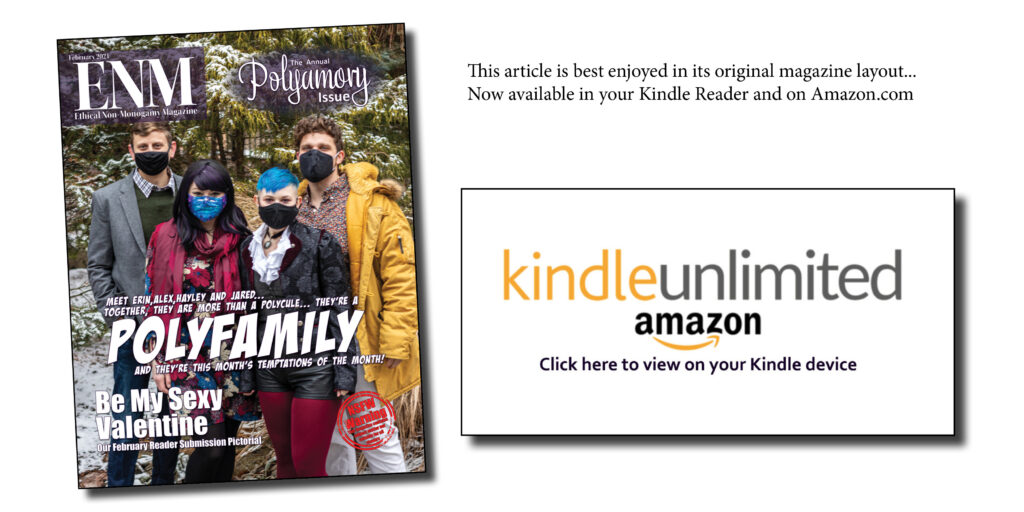
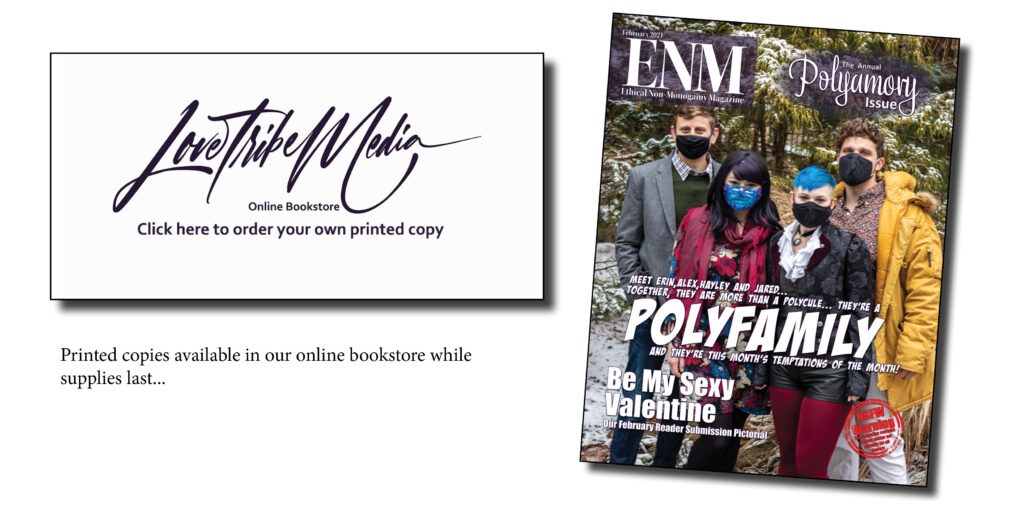
Comments are closed